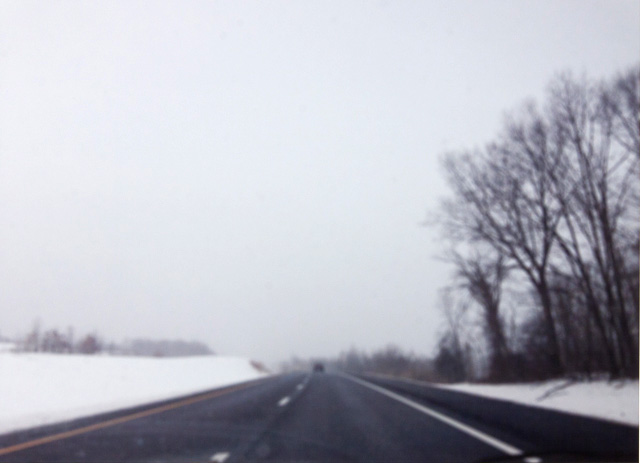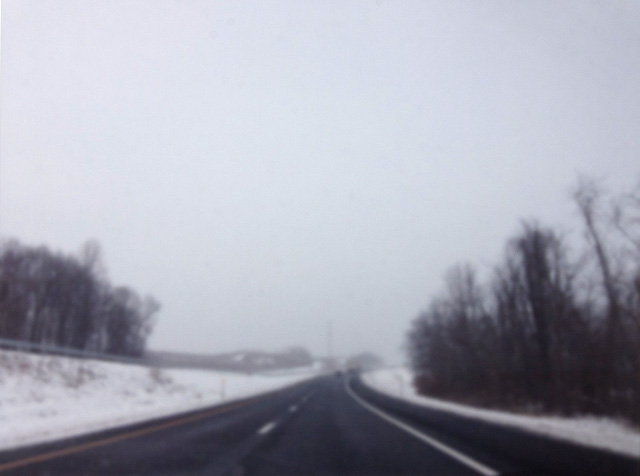David Gyscek
Visiting Assistant Professor in Art/Photography, Skidmore College

Habits of Seeing: 112-seconds in January, 2015, 2015, David Gyscek, Archival inkjet prints with gouache.
[Keywords: erasure, photography, imagination, perception, experience, phenomenology, epistemology, Kant, Sontag, Barthes, Friedlander]
Here is the problem: we understand the passage of time and our experience of it as continuous. We conceptualize it as a line punctuated by various data – whether important events in the history of a nation, significant occasions in one’s life, or as various sensory perceptions that make up one’s moment-to-moment experience of the world. Even in writing this, I am struck by how written language reflects this phenomenon. Each word only makes sense or only communicates the author’s idea by the words around it and the punctuation marks that organize and give structure to the thought being constructed by this combination. On an even more basic level, however, the spaces between the words are what allow them to be words in the first place. Without spaces, there would only be a series of virtually indecipherable letters (#nodistinctionsnomeaning). Those spaces aid in our comprehension of the idea being expressed, but it seems to me that they reveal, metaphorically, a distinction between our understanding and experience. Our understanding is punctuated while experience is continuous. It is the difference between the staccato beat of a drum and the sustained note of an organ; it is the difference between the ticking of a clock (analog, of course) and the smooth sweep of the second hand on a Rolex; it is the difference between looking at the frames on a film reel and watching that film projected. I am interested in the faculty that allows us to weave together the various inputs of experience to bridge the divide between those bits of information and our continuous experience and understanding of them; I am interested in the spaces between words and the silence between the ticks of a clock. What happens between the tick and the tock?
This problem manifests in nearly, if not all, human endeavor. My own disciplinary focus, photography, illustrates it acutely, and it motivates this current body of work. In The Ongoing Moment, Geoff Dyer says, “In photography there is no meantime. There was just that moment and now there’s this moment and in between there is nothing.” [1] Except, our experience of the real continues between the clicks of the shutter. Nevertheless, there is a consensus that the camera creates a reliable analog image of the subject at which it is directed. We can discern, fairly quickly, the special relationship photography has with the real. In On Photography, Susan Sontag writes that, “Photography has become one of the principal devices for experiencing something.” [2] We understand the real more fully through the photograph. If we were to imagine a medium capable of most accurately reproducing our experience of the real however, it would be something like an immersive real-time all-over video, a virtual-reality sensory feast. Again, we don’t have to imagine a medium that reproduces bits of visual data taken directly from the world – photography fits that bill and the problem is exposed once again. Our understanding does not match our experience.
There is a wonderful anecdote/parable attributed to Lee Friedlander and told by Michael Fried in Why Photography Matters As Art As Never Before. It describes the discrepancy between how we see and how the camera sees. By extension, it begs the phenomenological question of how we experience visual information unaided by a camera. Friedlander says, “I only wanted Uncle Vernon standing by his own car (a Hudson) on a clear day, I got him and the car. I also got a bit of Aunt Mary’s laundry and Beau Jack, the dog, peeing on the fence, and a row of potted tuberous begonias on the porch and 78-trees and a million pebbles in the driveway and more. It’s a generous medium, photography.” [3]
Where photography is complete and total in what it is able to visually capture (within the limits of its frame and its conversion of three-dimensional space to two), what we perceive, unaided by the camera, is selective. With this understanding I wonder if we simply focus our eyes differently than a camera lens does or if there are other processes occurring beneath the surface.
Clearly, human eyes function and collect visual information differently from how a camera lens does; to start, humans have peripheral vision. How we process that information is the part that is of interest to me. Imagination, I contend, is that faculty that bridges the divide between perception and being – between experience and understanding. The imagination allows the mind to process all of the disparate sensory inputs and weave them together into a unified and continuous experience. It is the glue that holds experience together, and therefore makes the real comprehensible.
In his first critique, The Critique of Pure Reason, Immanuel Kant claims that, “There are three subjective sources of knowledge upon which rests the possibility of experience in general and the knowledge of its objects – sense, imagination, and apperception. Each of these can be viewed as empirical, namely, in its application to given appearances. But all of them are likewise a priori elements or foundations, which make this empirical employment itself possible.” [4] Kant argues that these multiple sources of knowledge come together as a synthetic manifold experience, stitched together by imagination:
What is first given to us is appearance. When combined with consciousness, it is called perception. . . . Now, since every appearance contains a manifold, and since different perceptions therefore occur in the mind separately and singly, a combination of them, such as they cannot have in sense itself, is demanded. There must therefore exist in us an active faculty for the synthesis of this manifold. To this faculty I give the title, imagination. Its action when immediately directed upon perceptions, I entitle apprehension. Since imagination has to bring the manifold of intuition into the form of an image, it must previously have taken the impression up into its activity, that is, have apprehended them. [5]
This is a sort of additive understanding of the imagination, but I would suggest that the opposite also happens – that the imagination also removes – erases objects of our sense perception. In addition to reconciling the disconnection between experience and understanding, imagination also allows us to remove superfluous information, sensations, or other inputs. This erasure of the real can be the product of consciousness selecting only the essential inputs for understanding any given situation – a sort of prioritization; or it can be a more active selection – one derived from desire, taste, or bias. The imagination allows us to see only what we want to see, allowing everything else to fall from our attention and consciousness.
It is this ‘imagining out’ of visual data that is the focus of my inquiry. In this project, the work of production (photographing, processing, and then painting) has become the primary mode of inquiry, of thought, of ideation. The products, these images, have become idea. Despite Roland Barthes’ assertion that, “Since the Photograph is pure contingency and can be nothing else (it is always something that is represented)… it immediately yields up those ‘details’ which constitute the very raw material of ethnological knowledge,” [6] the idea presented in these images attempts to strip out those “details” that would allow for specific knowledge of the real space being represented. In so doing, the photographs become generic and non-specific. Their link to the real is weakened and the idea they embody is reinforced.
References
1. Geoff Dyer, The Ongoing Moment (New York: Vintage Books, 2005), 120.
2. Susan Sontag, On Photography (New York: Penguin Books, 1971), 10.
3. Lee Friedlander, as quoted in Michael Fried, Why Photography Matters as Art As Never Before (New Haven: Yale University Press, 2008), 272.
4. Immanuel Kant, Critique of Pure Reason, trans. Norman Kemp Smith (New York: St. Martin’s Press, 1965), 141.
5. Kant, Critique of Pure Reason, 144.
6. Roland Barthes, Camera Lucida (London: Vintage, 1981), 28.
Bio
David Gyscek is an artist and educator living in New York City. He studied philosophy and studio art as an undergraduate at the College of the Holy Cross in Worcester, Massachusetts, and completed his graduate studies in fine arts at Goldsmiths College, University of London in 2000. He has exhibited in the UK and regionally in the US, including the recent group shows The State of Photography at Nazareth College in Rochester, New York, and Exposed at Gold Gallery in Boston, Massachusetts. He is currently serving as Visiting Assistant Professor at Skidmore College.














